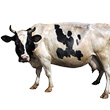Associate Professor, Dr. LÊ VĂN THỌ
According to Vietnam Animal Health Department report on October 27th, 2013, there are three provinces (Thanh Hoa, Ha Tinh and Quang Tri) which has been confirmed of FMD disease in 21-day period. FMD is an acute contagious disease which can quickly spread out to other provinces and result in serious losses for stockpeople. We would like to provide some information of FMD and how to prevent it in the most effective way.
PathogeN
PathogeN
- Virus belongs to genus Aphthovirus, family Picornaviridae, ARN virus, specialized by hydrated in epithelium cell layer (caused pus vesicles).
- 7 serotypes of virus cause FMD: A, C, O, Asia 1, SAT1, SAT2 and SAT3.
- Cattles in Vietnam is susceptible to 3 serotypes: A, O, Asia 1.
- Goats and sheep suffer from mild FMD caused by type A, C.
- Pigs are more susceptible to type O, and less susceptible to type A and Asia 1.
- In natural environment , virus can survive for 14 days in summer, 4 weeks in winter.
- Disinfectants such as BIOXIDE, BIODINE ®, BIOSEPT ® are effectively used to eliminate FMD virus. Virus can also be killed at 70°C.
Susceptible animal
- Cloven-hoofed animals such as buffalo, cow, goat, sheep, pig, wild buffalo, wild cow, wild pig, and deer are susceptible with FMD virus. Horses and avians are not infected by this virus.
- Infection on young animals is more severe and can result in death.
- In natural habitat, FMD virus can be cross infected between animals.
- FMD virus can transmit to human but rare.
Is FMD in animal related to hand, foot and mouth disease in human?
- FMD in human caused by Coxsackie virus A16 and Enterovirus 71 (EV – 71), which belongs to enteric virus and not relate to that causes disease in animals.
- Neurological problems and meningitis are usually a complication of enterovirus 71.
Transmission
- Virus is found in saliva, faeces, urine, semen, milk, vesicle discharge from infected animal or in air, etc.
- Virus can be transmitted through digestive or respiratory routes via feed, drinking water or inhalation (via nasal mucosa).
- Direct contact between infected animal and healthy animal.
- Indirect contact via stockpeople, transporting vehicles, waste materials, slaughterhouse, trade of infected animals.
- Pigs can shed virus into environment for 1 – 2 months, and cattle can shed for 3 – 6 months after recovery. Therefore, be aware that free-range cattle on fields raise a high risk of acquiring virus from these carriers.
Clinical signs:
- Incubation period: 2-7 days
- Fever (>40 ºC), anorexia or inappetite, depression, regular recumbency, lameness. There might be signs of pain in the feet; affected pigs prefer to lie down and, when forced to rise, the animal might walk gingerly and occasionally shake a leg as its painful.
- Profuse, frothy saliva around the mouth
- Vesicles may appear inside the mucous membrane of mouth, on the tongue, cheeks, gums, lips, nose, palate, and color varies from red to yellow or gray
- Ulcerated vesicles are also form between the claws of the feet and along the coronary band which cause dry separation of the heels along the coronary band thus making the animal reluctant to walk.
Ulcerated vesicles often appear on the teats of farrowed sows, causing inflamed with discharge and cracked teats. Infected teats become too painful for sows to allow their piglets to suck. FMD virus also cause abortion in pregnant animals.
Treatment
.jpg) |
| Vesicles found on tongue and oral cavity |
.jpg) |
| Vesicles found on nose |
.jpg) |
| Loose-off hoofs in pig |
.jpg) |
| Vesicles found on cattle limb |
Treatment
- Although there hasn’t been any specific treatment for FMD, vesicles and erosions in mouth, tongue, legs, and teats must be treated to prevent the secondary infection, the loose of hooves, and enhance the ability to recover. The treatment should be applied locally and generally.
- Localized treatment: rinse the ulcerated vesicles found on mouth, tongue, leg, hoof, teat with one of following solutions: normal saline, acid citric 1% or potassium permanganate 1%, alum 2%, blue methylene 1%, (or use juice of sour fruits like starfruit, lemon for washing ulceration in mouth, tongue twice a day). For buffalo and cattle, after cleaning the wound in teats and limb with normal saline and drying, apply antiseptic then ointment over the wound. Bandage all legs for the prevention of flies.
- Generalized treatment: BIO-CEVIT or BIO-ADE+B.COMPLEX to enhance the immune system. For the effective treatment of secondary infection, using BIO-TYLOSIN-PC or BIO-D.O.C ® antibiotic.
- Keep pens clean and dry with rubber sheet for lameness prevention. Feed animal with soft and digestible food. Keep warm for animal in cool areas. In good living condition with suitable treatments, animals will recover after 10 – 15 days.
- to enhance the immune system. For the effective treatment of secondary infection, using BIO-TYLOSIN-PC or BIO-D.O.C ® antibiotic.
- According to Vet Legislations, FMD infected animals must be incinerated or buried deep and covered with disinfectants.
- It is essential to maintain strict biosecurity practices and sanitation. Due to the recovered animals still shed virus in long period of time, disinfection of livestock pens, buildings, vehicles and equipment should be repeat every two days to eliminate pathogen and prevent the transmission.
- Restrict or stop all free-range animals in fields near the area suspected FMD/ FMD-risk region
- Provide as much distance between swine and cattle pens to prevent introduction/spread of the virus.
- Vaccination. In Vietnam, recommend to use multivalent vaccine which contains 3 serotypes (A, O, Asia1) for both pigs and cattle for effective prevention. Animals should be vaccinated twice per year as the immune system will last for 6 months after vaccination.
- Only consume animal products preserved in good condition, which have been labeled by the authorized veterinary office. Do not home-slaughter, or transport and trade sick animals.

 Hotline:
Hotline:

.jpg?width=120&height=90&mode=pad&anchor=auto&scale=both)









Comments